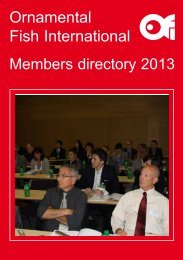Import and Export legislation - Ornamental Fish International
Import and Export legislation - Ornamental Fish International
Import and Export legislation - Ornamental Fish International
You also want an ePaper? Increase the reach of your titles
YUMPU automatically turns print PDFs into web optimized ePapers that Google loves.
Legislation<br />
<strong>Fish</strong> health Regulation<br />
In 1920, rinderpest<br />
occurred unexpectedly in<br />
Belgium, as a result of<br />
zebus, originating in<br />
India <strong>and</strong> destined for Brazil, passing<br />
through the port of Antwerp. Massive<br />
mortalities among Belgian cows were<br />
the result.<br />
Despite the inevitable slowness of the<br />
negotiations undertaken through<br />
diplomatic channels, twenty-eight<br />
countries reached an "international<br />
agreement" on 25 January 1924 on<br />
measures to prevent such outbreaks in<br />
the future. The ratification of this 1924<br />
Agreement created the Office<br />
<strong>International</strong> des Epizooties (OIE)<br />
based in Paris. Today the OIE is the<br />
world organisation for animal health<br />
<strong>and</strong> numbers 167 members worldwide.<br />
This does not mean that the problems<br />
of animal diseases have been solved.<br />
Since 1920, the volume of animals<br />
transported around the world have<br />
only increased year by year <strong>and</strong> with<br />
that also the risk of the spread of<br />
disease. However, without the OIE it<br />
would perhaps have become<br />
impossible to find healthy cattle<br />
anywhere in the world at present.<br />
OIE has made a list of diseases that<br />
are so dangerous that worldwide<br />
measures are needed. If a disease<br />
from this list has been detected in one<br />
of the member countries, it must be<br />
reported to the OIE office in Paris.<br />
Furthermore a series of measures<br />
were adopted, based on scientific<br />
81<br />
<strong>Ornamental</strong> <strong>Fish</strong> <strong>International</strong><br />
research, to prevent the<br />
further spread of disease.<br />
Measures include a<br />
notification system,<br />
international cooperation,<br />
the establishment of disease-free<br />
countries, zones <strong>and</strong> farms, regular<br />
controls by national veterinary<br />
authorities <strong>and</strong> import restrictions in<br />
disease-free zones.<br />
Health status<br />
The guidelines include the possibility<br />
that countries, zones or farms can<br />
thrive on an official disease-free status,<br />
for the relevant disease. Countries<br />
might decide to implement such a<br />
policy to protect their aquaculture<br />
production, however, programs to<br />
attain disease-free status dem<strong>and</strong> long<br />
periods of testing according to the OIE<br />
approved methods <strong>and</strong> regular<br />
controls (see OIE manual). The costs<br />
do not often weigh up against the<br />
benefits of a disease-free status.<br />
<strong>Fish</strong> diseases<br />
Several fish diseases are also<br />
mentioned in the OIE list of notifiable<br />
diseases:<br />
o Epizootic haematopoietic necrosis<br />
(EHN)<br />
o Infectious haematopoietic necrosis<br />
(IHN)<br />
o Spring viraemia of carp (SVC)<br />
o Viral haemorrhagic septicaemia<br />
(VHS)<br />
o Infectious pancreatic necrosis (IPN)<br />
o Infectious salmon anaemia (ISA)<br />
o Epizootic ulcerative syndrome (EUS)<br />
o Bacterial kidney disease (BKD)<br />
o Gyrodactylosis (Gyrodactylus salaris)








